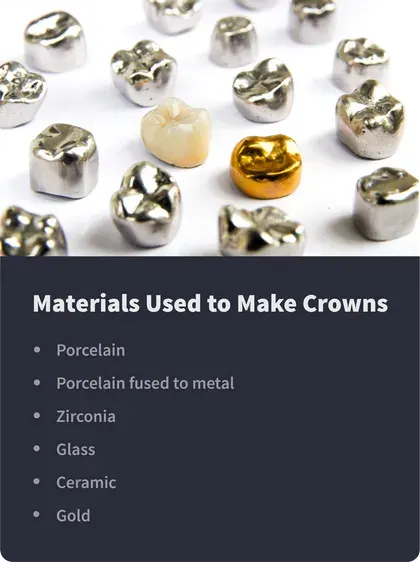Gold Crowns: Uses, Frequency & Costs

Table of Contents
- History of Gold Crown
- Popularity of Gold Crowns
- Cost of Gold Crowns
- Cost Factors of Gold Crowns
- When to Use a Gold Crown
- Advantages of Gold Crowns
- References
The use of gold crowns in dentistry has been around for thousands of years, but they generally cost more than other types of crowns and are more visible.
They are most popular with celebrities and others who wish to show them off. The rising cost of gold and high visibility of gold crowns make them less popular with the general public.
Gold crowns have several advantages, including longevity and durability. A gold crown can help to protect a tooth from further damage or decay. It may be a good long-term option for holding a tooth’s shape and structure.
History of Gold Crowns
Gold crowns have been used to cap teeth dating back to 700 BC, as ancient civilizations seemed to see them as a measure of wealth. Skeletons from tombs dating thousands of years ago have been excavated with gold crowns in their mouths. Gold has long been heralded as a symbol of royalty and prominence in society.
At one point, gold crowns were often placed in the back of the mouth where they would largely go unnoticed and unseen. They were more utilitarian.
In the mid-20th century, gold crowns became a status symbol for those who could afford them, including politicians. Gold crowns are now being used to bling out entire mouths and on front teeth as well as back ones.
Popularity of Gold Crowns
Today, gold crowns are highly popular with celebrities who often choose gold crowns and tooth caps intentionally.
Bejeweled mouthguards, or grills, rose in popularity in the hip hop community in the 1980s and often accompany gold teeth and crowns. Jewelers are now producing grills encrusted with a number of different kinds of jewels, and these can go for several thousand dollars a pop.
Gold crowns are often seen as a fashion statement, worn by rappers and celebrities. It’s not common to use gold for medical reasons today, as there are less expensive and less visible options.
The Cost of Gold Crowns
For general use, gold crowns are less popular than other materials as they are so highly visible, and the price of gold makes them more expensive as well.
Dental crowns can range in cost from $500 to over $3,000. Using gold or a gold alloy can increase the typical cost of a crown an average of $600 to $2,500 or more per tooth.
Dentists today typically combine gold with other metals, such as palladium, nickel, or chromium and this increases the strength of the crown while reducing cost.
Factors Impacting Cost of Gold Crowns
Gold crowns are typically made from a gold alloy. The more actual gold in the alloy, the higher the price will be. The market price for gold can fluctuate, which can change the price of a gold crown as well.
Additional factors influencing the cost of your crown include:
Where the crown is being placed. The more difficult it is to reach the tooth, the more the crown will cost to place.
The extent of the procedure. When procedures take longer and are more difficult to perform, the cost can go up accordingly.
Who places the crown. The more experienced the dental professional placing the crown, the more expensive they are likely to be.
Your geographic location. Dental work and the cost of crowns are highly variable. Prices often vary according to where you live.
Services needed. The more services you need, such as x-rays, medications, root canals, deep cleaning, and extensive preparation, the more your overall cost will likely be.
Most of the time, a crown is considered a medically necessary procedure, which means it is at least partially covered by insurance. A gold crown specifically, however, may not be covered as it can be classified as unnecessary and cosmetic. Discuss your insurance plan and policy with your provider to determine if part of your gold crown will be covered and how much.
When to Use a Gold Crown

A dental crown is a cap that is placed on a tooth to reshape it or enhance its structure. A crown is often placed after a root canal. During the root canal, infection is cleaned out after tooth decay has eaten away part of the tooth. A crown may also be used to repair a cracked, chipped, or broken tooth.
Ultimately, a crown is a type of prosthetic device that is meant to strengthen your tooth and improve your appearance, often helping to restore a tooth’s shape and size in the process.
There are several types of materials used to make crowns.
Porcelain crown: This is the most popular type of crown.
Porcelain fused to metal crown: This uses a metal structure coated with porcelain.
Zirconia crown: This is a newer type of material with similar aesthetics to porcelain but the strength of metal.
Glass crown: This option can be aesthetically pleasing, but it is less durable.
Ceramic crown: This is a strong and durable choice.
Gold crown: This is one of the strongest and longest lasting types of crowns.

Gold crowns are often used when your tooth needs more support than can be offered with a traditional crown. This can be needed due to significant tooth decay, trauma, a root canal that requires more coverage, to cover a dental implant or dental bridge, or to restore a tooth.
Advantages of Gold Crowns
Gold crowns are often considered mostly for back teeth that are less visible since they are going to stand out more than a porcelain or composite crown, which can more closely match the color of your teeth. There are several advantages to using a gold crown over alternative materials.
Gold crowns have been shown to be very sturdy and stable. They last well over 10 years, lowering the need for multiple crown replacements in your lifetime.
Gold is an extremely strong metal. These crowns can withstand a lot more force than some of the other types of crowns. If you tend to chew heavily, gold crowns can be an excellent choice.
A gold crown will usually wear teeth nearly as equally as your normal enamel. When you bite down against a crown, your opposing teeth are not damaged as easily.
Gold crowns require less of the tooth to be removed prior to placing them. This can help to preserve more of your natural tooth, meaning that the procedure is not as extensive.
Gold crowns tend to chip and break less often than porcelain and composite material crowns. They are typically considered to be more durable and long-lasting. While they can cost more up front, this can save you money on a replacement in the long run.
Gold crowns can also be made with a combination of other metals, which can help to decrease the overall price while still maintaining the benefits and advantages of the gold crown. Many dental providers and offices will find ways to work with you on financing. Some offer dental discount plans to lower or break up the overall costs.
